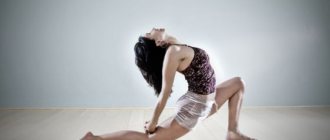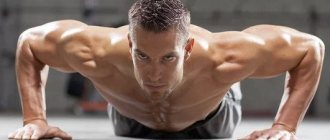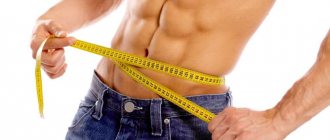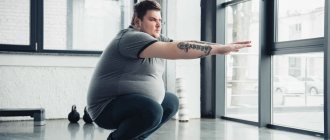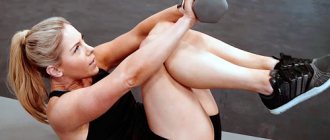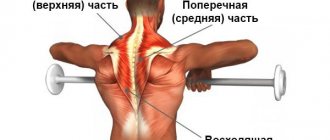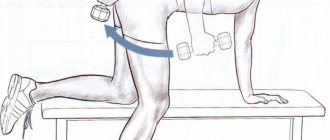If you regularly perform spinal exercises at home, you can gradually relieve back pain and discomfort. As a rule, it is not possible to completely cure diseases of the spinal column. However, constant attention and a well-designed set of exercises for the spine at home are the key to a stable back condition for many years. In addition, negative processes occurring in the spine can cause a number of concomitant diseases. By training your back, you can successfully fight other pathologies.
Spinal stretching exercises
One of the most effective sets of exercises for back health is spinal stretching. When the spine is stretched, the distance between the vertebrae increases, resulting in less pressure on the deformed discs and nerve. Periodic stretching can reduce back pain.
When performing exercises at home, you should not try too hard, move abruptly, or increase the amplitude as much as possible, especially if you do not know exactly what condition your spine is in.
Hanging on the horizontal bar
These are the simplest exercises for stretching the spine at home. It is better to perform them on a horizontal bar, the height of which exceeds your height, so that you do not have to bend your legs. While hanging on your hands, breathe evenly, do not hold your breath. There are no clear limits on how long you can hang; if you feel tired, drop to the ground and take a break. You should return to the horizontal bar only after a break. Hanging on your legs upside down is performed in the same way, but is not recommended for people with poor physical fitness.
"Child's Pose"
Lie face down on the floor. Place your palms on the floor directly under your armpits and push up while pushing your knees. In the intermediate position you will be on all fours. Do not linger and lower your chest to the floor, while your arms straighten. The body forms a triangle with the highest point at the pelvis. Face the floor, do not bend your arms, just let them lie on the floor. Gently get out of this position as soon as you feel tired.
"Cat"
Get on all fours and arch your back as far as you can. Aim to touch your chin to your chest. After a few seconds, bend your back down, your face rises up. Alternate up and down curls 10-15 times.
Stretch marks on the floor
Sit on the floor and spread your legs as wide as possible. Slowly lower your body towards the floor as far as the stretch allows. Stay in this position for a while, and slowly rise up when you get tired or feel discomfort. Your back should be straight throughout the entire exercise.
Crunches
Starting position as in the previous exercise. Bend one leg slightly at the knee and turn your body towards it. The back remains straight. Place your hands on your knee or thigh, depending on how flexible you are. Switch legs and repeat the twist. Breathe freely. Perform 4-5 approaches.
Do the twisting while exhaling.
Who needs it?
The modern lifestyle is characterized by low mobility - physical inactivity. And by nature, the human body is created for the active life of a predator. To keep yourself in optimal shape, you cannot do without a set of exercises and regular exercise. The spine needs to be strengthened first; it is the foundation for the whole body.
You should do back exercises to:
- Significantly and without drug intervention reduce pain and discomfort in the spinal muscles (arising, for example, with scoliosis).
- Get rid of clumsiness and awkward movements, become more flexible.
- Undergo prevention or treatment of various diseases.
The complex for improving the condition of the back, depending on the goal pursued, is divided into two categories:
- To stretch the muscles of the spine. Prescribed for a number of diseases, such as osteochondrosis, curvature.
- To strengthen it. It is effective both in the treatment of pathologies and in the prevention of diseases and some complications of serious diseases.
Exercises to straighten the spine
"Skydiver"
Starting position: lying on your stomach. Raise your arms and legs at the same time and hold them in this position for as long as you can. If physical fitness does not allow, lift one limb at a time diagonally.
"Basketball basket"
Lying on your back, lift your knees up and clasp your arms. Pull them towards you, while at the same time reaching towards them with your head. Execution time – 15-20 seconds. Repeat 5-10 times.
"Table"
Sit on the floor and lean on your arms out back. Bend your knees and rest on your feet. From this position, lift your body parallel to the floor 15-20 times. You shouldn’t lift slowly, but at the highest point, stop for a few seconds and start lowering your body. One approach.
Mechanism of development of osteochondrosis
The spine has 33-35 vertebrae, between them there are elastic discs. They give the spine elasticity and flexibility. Each such disc contains a core framed by an annulus fibrosus and covered above and below with cartilage.
With osteochondrosis, blood circulation in the spine itself and metabolism in it suffer. The elastic discs that are located between the vertebrae begin to dry out, their elasticity and strength are lost, and their height decreases. Gradually, the fibrous ring loses its ability to support the loaded spine, and it protrudes. It happens that the fibrous ring ruptures, and this leads to an intervertebral hernia.
Due to such disorders, the mobility of the entire spinal column may be affected and its curvature may occur.
A favorable environment for spinal health is an active and sporty lifestyle with moderate load and without overexertion.
In our age of computerization, a person’s lifestyle is mainly sedentary. Prevention and treatment of problems with the spine is physical therapy (physical therapy), which improves the trophism of the discs between the vertebrae, because of this, joint mobility improves; blood saturation of the entire spine also improves, the muscular system of the back is strengthened, and the destruction of the bone components of the spine is slowed down.
Exercise therapy for osteochondrosis is especially useful for people with predisposing factors:
- Elderly age.
- People who are constantly in an unusual body position.
- People with weak muscles and ligaments.
- Who has flat feet and club feet.
- With existing vertebral injuries.
Osteochondrosis of the spine has different localization and is divided into osteochondrosis of the cervical spine, thoracic and lumbosacral spine.
Exercises for spinal static disorders
Violations of the static function of the spine include various curvatures: scoliosis, lordosis, kyphosis, flat and round back, etc. The main treatment for static disorders is conservative, it includes special exercises, massage, swimming. If the disease is acquired, the emphasis in treatment is on therapeutic exercises.
- "Swimmer". Lie on your stomach, straighten your legs and keep them together. Extend your arms in front of you and begin to spread them to the sides, imitating the movements of swimming. Perform the exercise at a moderate pace until you get tired, repeat 3-5 times.
- Starting position – the back of the head, buttocks and shoulder blades should touch the wall. Alternately lift your left and right shoulders, then engage both shoulders.
- Standing on the floor, clasp your hands at your lower back. Lean forward without arching your back and lift the lock as high as possible. Perform at a slow pace.
- Place your hands behind your back and press your palms against your shoulder blades. It's okay if you don't succeed the first time: lift them as close to your shoulder blades as you can. Pressing your hands to your back, squeeze and spread your shoulder blades.
- Lie on the floor with your arms parallel to your torso. Bring your legs together and lift them, try to throw them behind your head. Perform the exercise slowly and carefully. Breathe freely, don't hold your breath.
- Starting position - as in point 5. Raise your legs together and perform scissors for 30 seconds. The closer your feet are to the floor, the harder the exercise. Repeat 3-4 times.
- Get on all fours and raise your arms and legs diagonally (right arm at the same time as your left leg and vice versa) parallel to the floor. Pause at the highest point and pull your hand and toe to the sides. Then lower the limbs and repeat with the other diagonal. Repeat 5-7 times.
How to pump up your wings at home
The so-called “wings” are nothing more than the outer parts of the latissimus dorsi muscle.
A set of exercises for this muscle group will include:
- Wide grip pull-ups are the best exercise. Using most of the muscles of the upper body, it places the main load on the “wings”. You can also ask your partner to move his legs about 45 degrees: in this case, the load on the wings will be even greater;
- Standing dumbbell fly : feet shoulder-width apart, torso leaning forward at a right angle, arms with dumbbells spread to the sides. The arms do not bend at the elbow: in this case, we remove the load from the target area.
- Abductions from dumbbells with emphasis on a bench . Take the dumbbell in your left hand. Leaning on the bench with the knee of your right leg and your right hand, position your stomach parallel to the bench. The arm with the load must be bent at the elbow and the dumbbell raised, moving it slightly behind the back; the movement is similar to working with a handsaw. The hand with the dumbbell is as relaxed as possible, we try to perform the movement with our back.
Gymnastics for the cervical and lumbar spine
Hanging on the horizontal bar
Hang on the bar and breathe evenly. Slowly pull your bent legs up and stay in this position for 15-20 seconds. Gently straighten up and repeat leg curls 2-3 times.
Let your muscles rest for a few minutes between sets.
Curls while hanging
As in point 1, hang on the horizontal bar and slowly turn your pelvis alternately to the right and then to the left. Try not to strain your back.
"Bridge"
Lie on the floor, place your arms along your body. Bend your knees and lift your pelvis up, resting on your feet. The arms and neck remain in place. Slowly lower your body down and repeat the exercise 10-15 times.
Circular movements of the hips
Standing on the floor, place your hands on your waist and begin circular movements with your pelvis, first to the right, then to the left. Repeat 5-10 times.
Neck exercises
- Pressure. Sit on a chair, join your hands and place them on the back of your head. Press your head into your palms and hold the position for 30 seconds. Do 2-3 approaches.
- Press your forehead onto the palm of your hand pressed to your head. Hold the pose for 10 seconds and repeat 5-7 times.
- Head turns. Sit up straight and alternately turn your head to the right and left sides. Perform 5-7 times.
- Lower your chin to your chest and turn your head in different directions, as in step 3.
- Lie on the floor, rest your elbows and lift your head up. Hold the position for about 30 seconds, then you can move on to turning your head. Do the exercise slowly.
Back diseases are always a serious pathology, affecting the functioning of almost all organs and systems. To prevent their development, regularly perform exercises at home and try to keep your back straight after gymnastics.
Why strengthen your back muscles?
With the development of technology, people spend more and more time at the computer, leading a predominantly sedentary lifestyle. Men and women began to neglect walking, replacing them with car trips. The absence of moderate loads on the spine and prolonged sitting negatively affects the condition of the spine, provokes curvature of the ridge and the appearance of hernias. All this results in pain in the neck and lower back, and can lead to more advanced stages. Timely care of your back, including a set of exercises, will help you avoid many diseases of the musculoskeletal system, including herniated discs. The classes are simple and can be done at home or in the gym.
The benefits of regular morning exercise
After waking up, many people do not have enough time for any training, since there are still many more important things to do. However, it is still worth devoting some time to exercise, if only because such an activity can increase the overall tone of the body, charge a person with vigor for the whole day, and also reduce or completely eliminate unpleasant sensations. Moreover, there is no need to purchase any special expensive simulators or master complex techniques. Morning exercises for the back and spine at home can be done in just 10 minutes.
This approach is much better than irregular training twice a week, even if it lasts a few hours. You can do it with your whole family, because even younger schoolchildren experience high stress due to sitting at their desks for a long time. The lack of such physical activity coupled with a sedentary lifestyle leads to many unpleasant consequences, for example, the development of scoliosis.
